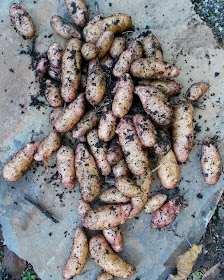 |
| Yummy biscuits and jam! Learn how to make salal jam in the recipe below. |
On our third-of-an-acre we are blessed with an abundance of salal, the Pacific Northwest Native American's word for Gaultheria shallon, an evergreen ground cover found abundantly in the Pacific Northwest. Our largest clump, a 10x15 rectangle, has already, by August 15th, produced enough berries to produce 12 pints of jam and there are plenty more berries to ripen during September.
The berries hang under the shade of thick leaves and ripen from August through September. Harvesting small batches and freezing allows you to gather berries at their peak before Pacific Northwest drought-like summers turn the plump berries into mummies. Once our berries started to ripen it only took two weeks to gather enough to process.
The berries resemble blueberries and have a similar taste. Slightly blander and less sweet, salal berries are much more earthy and slightly "smokey". We combined two different recipes to come up with our own, and in our opinion, a superior one.
Because we do so much cooking, canning, and processing we purchased the Fruit and Vegetable Strainer attachment for our Kitchen Aid which was the perfect tool for processing the salal berries. When harvesting the berries it is very difficult to extract them from the bush without the small stem so in the interest of saving time we just left them on and processed them in that state (see the previous picture). Juice and pulp out one end, stems, skins, and seeds out the other!

As you can see in the picture above some seeds and skin go through the extractor and you are left with a thick juicy mixture. Because we wanted jam, not jelly, we added a little water to the "waste" product, reboiled it and put it through the processor again to get all the tannins and nutrients from the berry skins. This made our jam a deep black/purple color and posses a wonderful texture. salal berries are high in pectin so some recipes don't add it. Others add apple juice for sweetener instead of sugar and add pectin. Because we added extra water during the second extraction process we decided to add sugar and pectin to insure setting.
24 cups of salal berries
1 cup sugar or to taste
1/4 cup lemon juice
1 pkg pectin
Run salal berries through a mechanized strainer/sieve. Set aside. Put cast-offs (waste) in a sauce pan and add 2-3 cups water. Bring to a boil for 2 minutes. Run mixture through strainer/sieve and add pulp to original juicy pulp. Discard "waste" product (or feed to the chickens). Bring juicy pulp, sugar, lemon juice and pectin to a boil, stirring constantly to prevent burning, for 1 minute until sugar and pectin are dissolved. Can jam according to standardized methods.
It's as easy as that!
Once all the berries are harvested from your salal it's time to trim up the plants to keep them tidy. You may be able to find a buyer for those lovely leafy stems which are used by the florist industry. Call around to your local florist or farmers market flower vendor.
Other uses for the leaves come to us via our Native Americans who used the plants medicinally. Here are a few ways they used these useful plants. The berries are said to be an appetite suppressant, the leaves have an astringent affect and are a natural anti-inflammatory and have anti-cramping abilities.
Wikipedia says this "By preparing the leaves in a tea or tincture one can take the herb safely to decrease internal inflammation such as bladder inflammation, stomach or duodenal ulcers, heartburn indigestion, sinus inflammation, diarrhea, moderate fever, inflamed / irritated throat, and menstrual cramps. A poultice of the leaf can be used externally to ease discomfort from insect bites and stings."
Wikipedia refernces Michael Moore, Medicinal Plants of the Pacific West, illustrated by Mimi Kamp, published by Red Crane Books, Inc.


 As for me, hunting does not carry the same intrigue as my husband, but I enjoy shooting shotgun at the range. I especially love Sporting Clays as it mimics the sport of hunting...you just don't have to kill anything! Because I don't take my gun to "the field" I bought a lovely Beretta 687 Diamond Pigeon. I feel good knowing that if need be I could actually bring down a bird for dinner.
As for me, hunting does not carry the same intrigue as my husband, but I enjoy shooting shotgun at the range. I especially love Sporting Clays as it mimics the sport of hunting...you just don't have to kill anything! Because I don't take my gun to "the field" I bought a lovely Beretta 687 Diamond Pigeon. I feel good knowing that if need be I could actually bring down a bird for dinner.














































